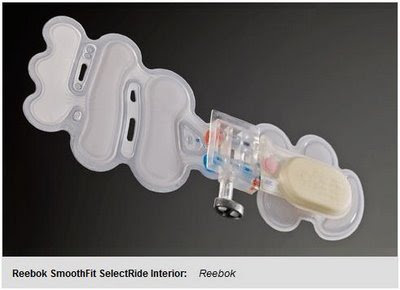Reebok Pump is Back on the Scene! Well, Sort Of
The company that first told you to 'Pump it Up' is launching a new 2-in-1 design that converts from a running shoe to a cross trainer... with nothing more than your footsteps
The original Pump sneaker (which we all remember well) was intended to optimize the shoe's fit; the new Reebok SmoothFit SelectRide goes the extra mile, offerering both the stability of a trainer and the cushion of a running shoe; and you don't even have to untie your laces. Launching next Wednesday, and available for $149.99 only at Champs Sports, the SelectRide is the second attempt by the footwear industry to design an intelligent shoe. The first attempt, the Adidas1, received a surge of press coverage but garnered only average sales. Reebok, which is now actually owned by Adidas, expects that the SelectRide will meet with much greater success.
"One thing we wanted to improve on for our shoe was the public perception. With the Adidas1, while you can put it on an impact machine and measure the changes, we wanted something where you can really feel the difference," Bill McInnis, Reebok's Managing Director of Advanced Concepts, said. "We were cognizant of someone trying it on in the store and making sure they can feel the difference in 5-10 steps."
The SelectRide has an inflatable bladder across the entire sole of the shoe. For your warm-up jog, just push the button on the side of the shoe marked 'run'. This opens an intake valve in a manual pump in the heel of the shoe. With each step you take, air is drawn into the bladder. After 5-10 steps, the shoe's sole lifts the foot up by an extra four millimeters, providing 21.6% more cushioning.
As air is pumped in through the heel, it passes through a one-way check valve and then into the forefoot bladder. The forefoot bladder is linked openly to the heel bladder to ensure the foot is 'lifted' in a uniform fashion as the pressure finds equilibrium. Each individual will actually have a slightly different amount of pressure in their bladder based on the force of their heel strike. McInnis explained that the range is normally between 6-8 PSI with some larger men reaching up to 12 PSI. A mechanical testing machine showed that to withstand a simulated heel strike load of 2000N, the shoe displaced 14 mm in running mode but just 11.5 mm in training mode.
When you're all warmed up and ready to diversify your workout, just push the 'train' button and the shoe reverts to a stiffer version of itself, with increased stability.
McInnis noted that while the Adidas1 relied on a complex circuitry and mechanical system, the SelectRide uses a simple air pump, and contains no moving parts. Testing on the shoe showed that the foam surrounding the shoe will start to break down before any problems with the bladder crop up. This level of simplicity provides a key advantage for the SelectRide over its predecessor.
"There's a significantly different price point that puts us in a different place. We're selling at $150 which is the price of other premium shoes. They were the only shoe above $200 and they were all the way up at $300. We expect our sales volume to be much higher," said McInnis.
Reebok relied on in-house expertise in designing the shoe, and drew upon intellectual property from older pump models. Any multi-functional technology raises the question of whether the combined effect will be as good as the separate parts. McInnis believes the answer is 'yes'. The shoe is just five percent heavier than the brand's best running shoe, and the stiffness of the shoe in each mode is consistent with Reebok's high-end lines for each category. After eleven rounds of development, they're confident that the SelectRide is robust enough to withstand rain, sweat, sand, and all of the pavement-pounding you might be inclined to subject it to.
By Brett Zarda,
Source: Popular Science

Comments